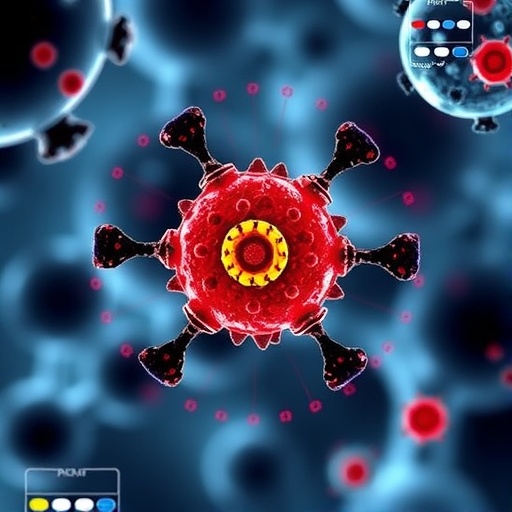In a groundbreaking study published in Nature Chemical Biology, researchers have unveiled a novel therapeutic strategy targeting the accumulation of mutant p53 proteins, which are increasingly recognized as pivotal players in the development and progression of various cancers. This revolutionary approach capitalizes on the innovative use of proximity-inducing drugs, providing hope in the ongoing battle against malignancies that are notoriously difficult to treat. This new line of research, spearheaded by a team including Sadagopan, Carson, and Zamurs, highlights the intricate balance of protein dynamics within cells and suggests that by manipulating these dynamics, we could substantially alter cancer treatment paradigms.
Mutant p53 is a highly prevalent oncogenic mutation found in approximately 50% of all human tumors, making it a prime target for cancer therapy. Understanding the mechanics behind p53’s dysfunctional behavior not only offers insight into cancer biology but also opens avenues for potential intervention. The wild-type version of p53 functions as a tumor suppressor, orchestrating cellular responses to stress, damage, and other oncogenic cues. However, its mutant counterparts can gain nefarious functions, promoting tumor survival and even metastasis. The dichotomy between normal p53 function and that of its mutant forms serves as the backdrop to this research, emphasizing the need for innovative approaches to mitigating their detrimental effects.
The research underscores a significant limitation in conventional cancer therapies: the inability to specifically target mutant proteins without damaging normal cellular functions. Traditional methods often lead to severe side effects and resistance mechanisms that render them ineffective over time. By utilizing proximity-inducing drugs, the study presents a novel framework in which drug-induced interactions can selectively target and destabilize the accumulation of mutant p53 proteins, leaving wild-type proteins largely unharmed. This selectivity is a game-changer in the realm of targeted therapies, as it signals a potential evolution in how we approach the treatment of cancer at the molecular level.
Details of the study reveal a meticulous design where small molecules are engineered to bind to mutant p53, inducing conformational changes that restore some wild-type characteristics. The researchers have identified specific regions of the mutant p53 protein that are amenable to such modifications, allowing the proximity-inducing drugs to exert their effects while minimizing off-target consequences. This specificity is crucial in reducing the risk of collateral damage associated with broader-casting chemotherapeutics, a recurring challenge that has limited the success of cancer therapy to date.
Furthermore, the exploration into the biochemical environment of the cell plays a critical role in enhancing the efficacy of these proximity-inducing drugs. By considering the cellular localization and abundance of mutant p53, the researchers discovered that dynamics such as protein interactions and post-translational modifications significantly influence drug action. The approach adopted in this study effectively targets the interplay between mutant p53 and other cellular components, resulting in enhanced therapeutic outcomes. Consequently, this highlights an important shift towards personalized medicine, where treatment can be tailored not just to the type of cancer but also to its underlying molecular profile.
As the research progresses, two key questions arise: Can these proximity-inducing drugs be effectively delivered to tumors in patients? And what are the long-term implications of using such targeted therapies? The authors of the study are optimistic, citing advances in drug delivery systems that promise to improve the targeting and uptake of these novel therapeutics in vivo. Moreover, preclinical models have demonstrated promising signs of efficacy, bolstering the case for eventual human trials. However, experts caution that additional studies are necessary to fully understand the pharmacodynamics and potential resistance mechanisms that could emerge.
Crucially, the study opens the door to exploring additional targets within the cancer genome, as mutant p53 is only one of many aberrant pathways involved in oncology. The methodologies pioneered here could very well be adapted to target other mutant oncogenes, paving the way for a suite of therapies aimed at combating cancer from multiple angles. By validating their findings, the authors have laid important groundwork for an enhanced arsenal in the ongoing struggle against cancer, suggesting that the future of cancer treatment may lie in the convergence of precision medicine and innovative drug design.
In summary, the research spearheaded by Sadagopan, Carson, and Zamurs represents a remarkable stride towards understanding and manipulating mutant p53 proteins, thus providing an attractive therapeutic avenue for future clinical applications. The potential for proximity-inducing drugs to selectively target mutant proteins without affecting normal cellular functions may change the way we approach cancer treatment, fundamentally altering the treatment landscape for patients suffering from this complex disease. The implications of this research extend far beyond the laboratory, promising not just improvements in patient outcomes but also a deeper understanding of cancer biology on a molecular level.
With further investigations and trials on the horizon, the scientific community watches closely as this transformative approach advances. If successful, it could usher in a new era of cancer therapy—an era defined by targeting not just the disease, but its underlying genetic and biochemical underpinnings, potentially revolutionizing our fight against what has been an enduring challenge in medicine.
The research results, while promising, underscore the importance of ongoing collaboration across disciplines, merging knowledge from molecular biology, chemistry, and clinical applications to contribute to the body of knowledge. Such integration is crucial as we uncover new drug targets and move closer towards therapies that not only extend survival but also enhance the quality of life for cancer patients.
Understanding the future implications of this work is essential. Beyond its immediate findings, this research ethos could lead to a broader understanding of protein misfolding and misfunction in diseases beyond cancer, encompassing conditions where protein aggregation plays a role. As we dive deeper into the world of protein dynamics and interactions, it is clear that the discoveries surrounding mutant p53 proteins may just be the beginning of a long and fruitful journey towards advanced therapeutic interventions in modern medicine.
The landscape of cancer therapy continues to evolve, and this research serves as a beacon, guiding scientists, clinicians, and policymakers as they navigate the future of oncological treatments with renewed optimism and a stronger focus on molecular precision.
Subject of Research: Targeting Mutant p53 Proteins in Cancer Therapy
Article Title: Mutant p53 protein accumulation is selectively targetable by proximity-inducing drugs
Article References:
Sadagopan, A., Carson, M., Zamurs, E.J. et al. Mutant p53 protein accumulation is selectively targetable by proximity-inducing drugs.
Nat Chem Biol (2025). https://doi.org/10.1038/s41589-025-02051-7
Image Credits: AI Generated
DOI: https://doi.org/10.1038/s41589-025-02051-7
Keywords: mutant p53, cancer therapy, proximity-inducing drugs, targeted therapy, protein dynamics, oncogenes, personalized medicine, drug delivery systems.
Tags: cancer progression and interventioncancer therapy innovationsgroundbreaking cancer research findingsmalignant tumor treatmentmutant p53 accumulationoncogenic mutations in cancerp53 dysfunction in tumorsprotein dynamics in cellsproximity-inducing drugsresearch on mutant p53therapeutic strategies for cancertumor suppressor mechanisms





